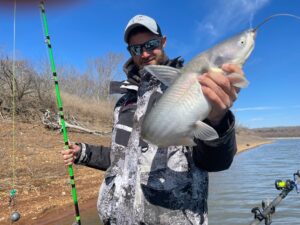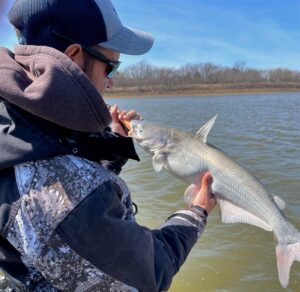Guide Jordan Leer uses a colorful Demon Dragon line floater to keep his hook
baited with cut shad off the bottom where it is more visible to hungry blue catfish.
Shad Tracker
By Brent Frazee
Missouri guide uses his electronics to locate the blue cat’s food.
Jordan Leer stared at the screen of his sonar device and spotted what he hoped to find. A bright yellow cloud of gizzard shad, suspended in the murky water of a shallow creek on Truman Lake’s upper end, stretched across most of the screen.
There was only one problem: The school of blue catfish that was supposed to be with the shad was nowhere in sight.
“More times than not, the blue cats will be right around the bait,” said Leer, who runs Angler’s Edge guide service on Truman, a 55,600-acre reservoir in west-central Missouri.
“But look at my side scan (which marks fish to both sides of the boat). Nothing here.”
Leer continued up the creek, his eyes glued to the screen, until he came across the opposite scenario. No baitfish, but plenty of gamefish.

“Some of those are gar or even paddlefish,” he said. “But a lot of those marks are catfish.”
Leer jammed two poles into the muddy bottom and tied them to the side of his aluminum boat, then he began baiting his hooks with chunks of freshly netted shad. Not long after he cast the lines into the middle of the creek, one of the rods slowly bent.
Leer grabbed the rod out of the holder and began reeling. At first, there was no tension, and he thought the catfish had escaped. But when he got the line halfway back, he felt the tug of a heavy catfish.
After a spirited fight, Leer pulled the blue cat into the boat and laughed at the fish’s escape routine.
“Sometimes they’ll run right at the boat and the line just goes slack,” he said. “You’ll never even know it’s there until you catch up with it.”
Leer spent the next 45 minutes catching and releasing fat blue catfish in the 20- to 25-inch range. There were no monsters. But there was plenty of action.
Leer was fishing in the back of a creek where the water was no deeper than six feet in the middle. The shad moved in there in search of warmer water on an early-spring day, and the blue cats followed like a pack of hungry wolves.
For Leer, it was a sign of good things to come. During the spring months, Truman’s big blue catfish will move so shallow that only a few feet of water will cover their backs at times.
Find the fish food and you’ll usually find the blue cats.
Leer will often idle across large expanses of water until he finds the shad bunched up. Then it’s time to cast.
A spring thing? Well, yes, but Leer catches blue catfish year-round at Truman. The sprawling reservoir is loaded with baitfish and healthy blue catfish.
Like many diehard catfish anglers, Leer has some of his best fishing of the year in the cold winter months, from late November through February. That’s when the shad will be suspended over deep water on the lower end of Truman, and the blue catfish won’t be far away.
It’s a different story in spring. As the water warms, the shad will move to the shallow creeks and mud flats. Leer will use the side scan on his electronics to look for schools of baitfish and the catfish that lurk on the edges.
He won’t anchor until he marks concentrations of catfish on his side scan. There are tricks to using those electronics.

“If I see the schools of shad busted up, you know the gamefish are active. Sometimes, you can actually see the fish chasing them on your electronics,” said Leer, 31, who lives in Edwards, Missouri. “If you see the baitfish tightly bunched up, it usually means there aren’t many catfish around. The baitfish are comfortable.”
The shad will move to the back of shallow creeks or on the shallow mud flats on the main lake when spring temperatures warm the water. The shad will spawn in May, and the blue cats will follow them into the shallows.
“Sometimes, I’m fishing in water as shallow as a couple feet deep,” he said. “That’s when it gets exciting. When you hook a big blue catfish that shallow, he’ll start splashing and jumping out of the water like a bass.”
When Leer fishes shallow, he often uses a Santee-Cooper rig. He uses 40- to 50-pound monofilament line with an 80-pound-test leader. He puts a sliding weight on the main line, with a two-way barrel swivel below. He will tie a leader to the other part of the swivel with a Demon Dragon line float and a 7/0 or 8/0 circle hook below. That Demon Dragon looks like a colorful topwater lure for bass but has no hooks. Instead, it is used to float the baited hook off to the bottom where it is more visible to catfish.
For Leer, those tactics have put hundreds of catfish in the boat over the last few years. He has guided for the last five years, learning the tricks of the trade from fellow guide Cody Vannattan.
Leer guided part time when he worked in a factory making Tracker Marine boats. When business slowed during the Covid-19 pandemic, he was temporarily laid off. That turned out to be a lucky break.
Leer fished nearly every day of the week, perfecting his methods, and eventually began guiding fulltime.
Today, he will guide six days a week in the spring, and he is in demand. He fishes for not only catfish, but big crappie, white bass, hybrids and walleyes as well.
But for many customers, catching a big blue cat is what intrigues them the most. Most of the fish reeled in are under the 26- to 34-inch slot limit in place for blue catfish. Blue catfish under 26 inches and over 34 inches are protected and must be released under the regulation. Still, there are occasional fish 35 inches and longer brought in.
“Truman still has a ton of blue cats,” Leer said. “And it has a ton of baitfish, too. Sometimes, those ‘overs’ can be hard to come by. But they’re in here.”
(Brent Frazee is an award-winning writer and photographer from Parkville, Mo., a suburb of Kansas City. He was outdoors editor of The Kansas City Star for 36 years, and now freelances for magazines, websites and tourism agencies.)


